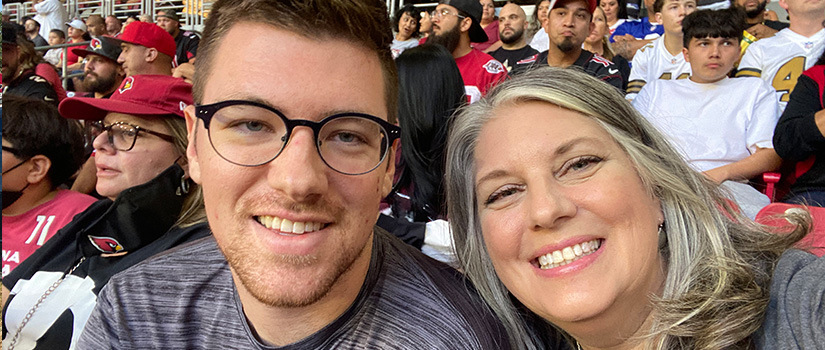Tice watches the game as it happens, along with countless other fans. The day after each game, he examines every second of every game – down to a fraction of a second – through hundreds of thousands of data points.
NFL players wear GPS trackers and accelerometers in their helmets and pads, which transmit data about their speed, location, trajectory and much more. NFL Next Gen Stats delivers this data to statisticians and computer scientists like Tice working for teams across the country.
“We use the data to predict different things about the upcoming games, depending on a variety of factors, down to the individual players they’ll be up against,” says Tice. “We’re trying to give the coaches as much information as possible to make the best decisions they can.”
These decisions can range from game strategies during the season to assessing which draft picks would add specific strengths to the team, which also requires data from additional sources.
I was a math and stats tutor at one point, which I think helps me quite a bit. You have to figure out how to convey your takeaways in way that they see the importance and trust that you're doing things correctly.
- Nick Tice, M.S. Statistics
Tice got the job working as a football analytics assistant for the Cardinals after interning for them in the summer in 2022, right after he graduated with his masters in statistics.
This job is exactly where he hoped he’d end up when he started in the Honors College at USC. Originally from Maine, Tice says he was drawn to South Carolina by the options available in USC’s College of Arts and Sciences.
“Of course, I’m also a big SEC football guy,” he says.
The sport and art of analytics
Statistical analysis in sports has become big business, as documented in the 2011 film Moneyball, which Tice says piqued his interest in this field.
The film tells the story of the first baseball team to effectively use analytics in 2002. While the sports industry was critical of the approach at first, other leagues, including the NFL, quickly followed suit.
“Most NFL teams probably have about five analytics employees,” Tice says. “Baseball teams are way ahead of the curve and can have 40 or 50 analytics employees. They are basically like small tech companies at this point.”
Getting a job in sport analytics is highly competitive, especially in the NFL. When Tice applied for the summer internship with the Cardinals, his resume was among hundreds the team received in just five days.
It was truly a dream, but one that he had worked for. After originally declaring a mathematics major, Tice switched to statistics to chase his dream of working in sports.
“After my freshman year at USC, I was talking it over with my parents and I decided to just go for it. I added sports management as a double major and decided on statistics because people working in sports analytics are usually stats or computer science majors.”
In addition to taking on two majors and later a master’s program that would set him in the right direction, Tice also tutored USC athletes throughout his undergraduate and graduate years, an experience that has been invaluable as he works for the Cardinals.
“I was a math and stats tutor at one point, which I think helps me quite a bit,” he says.
“When I'm talking to the coaches or to front office people, they don’t know about statistics for the most part. You have to figure out how to convey your takeaways in way that they see the importance and trust that you're doing things correctly.”
Increasing your odds of success
While professional sports analytics jobs are in high demand, aspiring statisticians do have ways to gain a competitive edge. Like Tice, studying a relevant field and learning the culture of sports goes a long way.
The NFL also offers a competition that Tice says is one of the best ways to get noticed: the Big Data Bowl, which gives everyone from undergraduates to professional statisticians a chance to show what they can do with a set of NFL data.
While Tice didn’t get his job through the Big Data Bowl, one of his colleagues with the Cardinals did – and Tice says the teams are always looking for new talent through the submissions.
“We all look into submissions and see what people are putting out there,” Tice says. “If your goal is to work in football, that's the best place to put your energy and really shine.”
Sports analyst is just one of many applied statistics jobs, and Tice says the field offers many possibilities for creative, fulfilling and competitive careers.
"I think statistics is probably one of the best degrees you can get,” Tice says. “The statistics department in the College of Arts and Sciences definitely helped me get to where I am today.”
